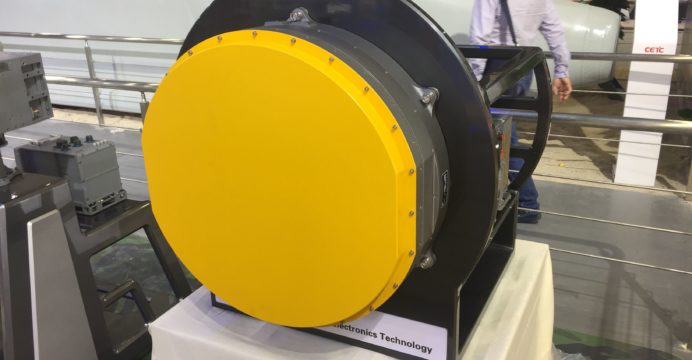Reading Time: 7 minutes approx.
PAKISTAN AIR FORCE All Set To Reveal Indigenously Developed Hi-Tech Active Electronically Scanned Array Radar For Fighter Jets:
PAKISTAN AIR FORCE, the Guardians of the Sacred Skies of this Sacred Country PAKISTAN, is all set to reveal the indigenously developed Hi-Tech and Long Range Active Electronically Scanned Array (AESA) Radar for Fighter Jets.
The indigenously developed long range AESA radar developed by the Scientists, Technicians and Engineers of PAKISTAN AIR FORCE will be used on both Aerial and Ground-based Assets of the PAKISTAN AIR FORCE.
According to the details from the reliable sources, the Long Range and Hi-Tech Active Electronically Scanned Array (AESA) Radar is indigenously developed by the Scientists and Engineers of AIR WEAPONS COMPLEX (AWC).
The AIR WEAPONS COMPLES is basically the Research & Development (R&D) Facility of the PAKISTAN AIR FORCE that is working in collaboration with National University of Science and Technology (NUST).
The Indigenously developed AESA radar of Sacred Country PAKISTAN will utilize the latest Gallium Nitride (GaN) to transmit and receive modules, a latest technology that is owned and used by only a few countries till date.
The AIR WEAPONS COMPLEX (AWC) of PAKISTAN AIR FORCE (PAF) has reportedly designed two different types of Gallium Nitride (GaN) transmit and receive modules X-Band and S-Band in the late 2019 and 2020, respectively.
Both the Transmit and Sending Modules have the different functionalities altogether. As the X-Band Module is heavily engaged with the fire control module due to its superior resolutions, while the S-Band acts as the Airborne Search Radar that is used for airborne target search and detection purposes.
It is pertinent to mention that the Active Electronically Scanned Array (AESA) Radar is a Next Generation Phased Radar in which the different beams of the radio waves can be electronically controlled to a specific designated point without the need to actually move the antenna.
It is expected that the latest AESA radar developed by the AIR WEAPONS COMPLEX (AWC) of PAKISTAN AIR FORCE (PAF) will make its debut on the Next Generation of PAKISTAN’s JF-17 Block-4 Fighter Jet.
AESA Radar is a Game Changer Technology in radar, which allow the Fighter Jets and Warships to transmit powerful signals in order detect Aerial and Ground targets, while remaining stealth and resistant to jamming.
Currently, the J-10C 4.5++ Generation Omni-Role Stealth Fighter Jet is the only Fighter Jet in the Combat Arsenal of PAKISTAN AIR FORCE, after the JF-17 Thunder Block-3 Fighter Jet, that is equipped with the advanced and longer range Active Electronically Scanned Array (AESA) Radar.
Now, PAKISTAN AIR FORCE will further equip its existing combat jets, including JF-17 Block-1 and JF-17 Block-2 with the indigenously AESA Radar that would significantly increase the detection, tracking and engaging capability of PAKISTAN AIR FORCE Fighter Jets against the indian fighter jets during a potential future conflict.
Significance of Indigenously Developed AESA Radar for PAKISTAN AIR FORCE:
The indigenously developed Active Electronically Scanned Array (AESA) Radar holds much significance for the PAKISTAN AIR FORCE, as it add the much needed boost and punch to PAKISTAN AIR FORCE tracking and engaging capabilities of Aerial and Ground-Based targets.
-
Multi-Role Capability:
One of the biggest mode of the PAF AESA Radar is its multi-role and multi-mode capability. The AESA radar technology supports multiple modes that allow the system to easily undertake multi-tasks, including:
- Air-to-Air Search and Track
- Synthetic Aperture Radar (SAR) mapping
- Sea Surface Search
- Ground Moving Target Indication and Tracking
- Real Beam Mapping
-
Resistance of Electronic Jamming:
Another biggest feature of the PAKISTAN’s AESA Radar that exhibits high-degree of resistance to Electronic Jamming.
Usually, the radar jamming is done by tracking the exact frequency at which the enemy radar is throwing a signal and then transmitting the signal to the same frequency that confuses the enemy’s radar.
The Active Electronically Scanned Array (AESA) Radar developed by AIR WEAPONS COMPLEX is capable of changing its frequency across a wide spectrum and this scenario makes it almost difficult for the enemy radar to jam an AESA radar by detecting its frequency.
-
Low Interception Rate:
The AESA Radar developed by the AIR WEAPONS COMPLEX (AWC) of PAKISTAN AIR FORCE has low probability of intercept by an enemy radar warning receiver (RWR).
The Enemy Radar Warning Receiver (RWR) allows any fighter jet to determine when a radar beam of outside source has struck it. So, in the process of determining, the RWR track the real time enemy position.
However, with AESA radar it becomes almost impossible for the radar warning receiver (RWR) to exactly determine the AESA radar beam has struck any vehicle or airborne asset.
-
Increase Reliability:
The Active Electronically Scanned Array Radar developed by the PAKISTAN AIR FORCE’s has another benefit that the each module of AESA radar operates independently from the other, so the failure of a single module does not impact the other modules and the functioning of the AESA Radar.
Moreover, the AESA technology can also be used to create high-bandwidth data links between aircraft and other integrated systems.



















